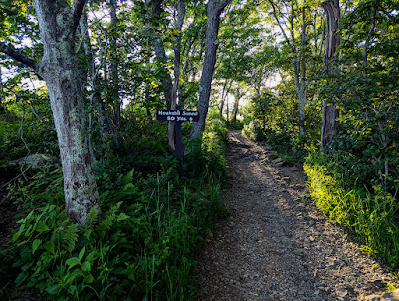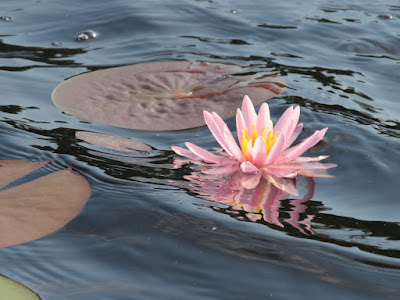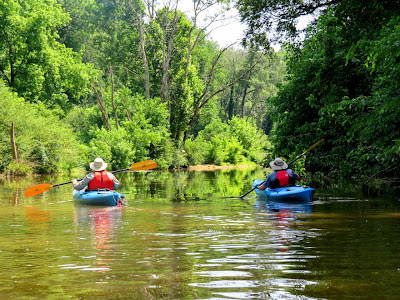Is it a bog or a swamp? I kept hearing it described both ways. After reading much I came to the conclusion that the swamp is within the bog. The Natural area is 1451 acres all within the Hight Point State Park. It is named for the family that donated the land to the state, Colonel Anthony R and Susie Dryden Kuser.
The bog has formed since the last glaciation (Wisconsin). The glacier's retreat left a fresh water lake at 1500' elevation. Over time the lake filled in with decaying moss which created a peat bog. The bog has within it different types of forest. Two hundred year old Atlantic white cedars make up one of those forests. Atlantic white cedar normally grows in low coastal areas. Here at 1500', it is quite unusual and rare, so rare, this may be the only population of Atlantic White cedars at this elevation or higher.
My hike began above the bog, following a ridge for about a mile before dropping down to the bog. It was a humid and hot morning. There is an old two track road that encircles the bog with a boardwalk passing through the middle. You could make out what appeared to be the contour of the ancient lake. A hardwood forest transitioned into a leafy bog with mosses, ferns and forest. There was much standing water as well. Almost immediately I was surrounded by Deer flies.
I walked the perimeter and the boardwalk. My pace was quick to try to stay one step ahead of the flies. There was Blue flag iris in water along the boardwalk. There were Rhododendron, Azalea, Mountain laurel, Blueberry and other heath family shrubs.
The rarer plants eluded me. I have read wild cala, pitcher plants and sundew grow here. I would have spent more time but the Deer flies were driving me out.
Blue Flag Iris
Atlantic White Cedar
After my bog tour, I left the bog and Deer flies, back into the surrounding hardwoods. It was a rocky trail with some up and down. My hike ended on pavement for the last mile. The heat and humidity coupled with the fast pace, did me in. I needed a 10 minute recovery period before feeling ok to drive off.
An eft scurries away
































































